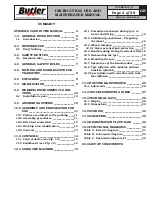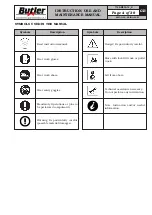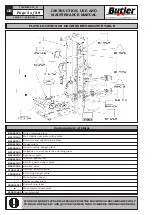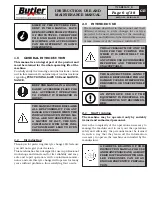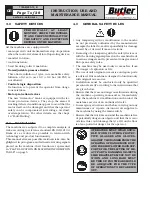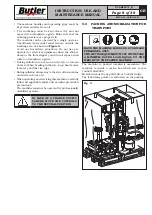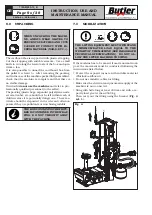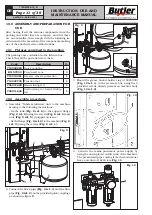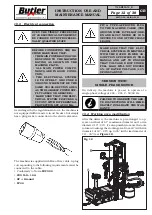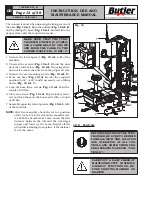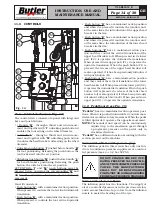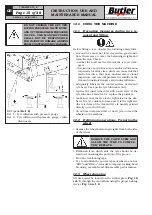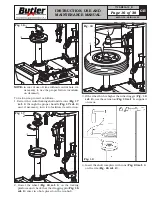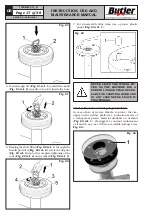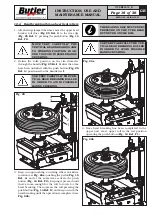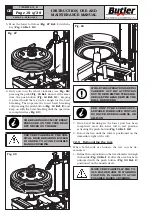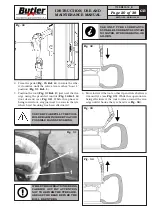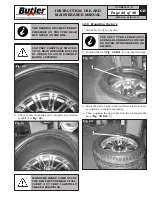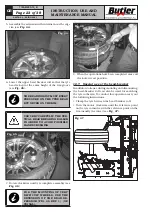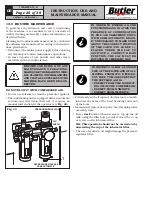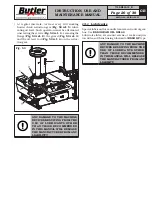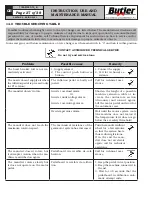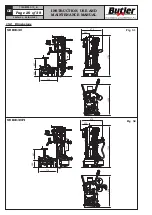
Page 14 of 38
GB
INSTRUCTION, USE AND
MAINTENANCE MANUAL
A
B
C
D
E
G2
G1
H
I
M
L
F1
F
F2
G
11.1 Control device (see Fig. 14)
The control device consists of a panel with integrated
keys and push buttons.
•
• Handle “
H
”
: through a thrust and return move-
ment and together with “
I
” unlocking push button it
enables the tool setting on the wheel diameter.
•
• Handle “
L
”
: through a thrust and return move-
ment and together with “
M
” unlocking push button
it enables the bead breaker rolls setting on the wheel
diameter.
•
Unlocking push button “
I
”
pushed before handle “
H
”
for tool positioning. Releasing the push button, the
tool locks itself into the set position.
•
Unlocking push button “
M
”
pushed before handle “
L
”
for bead breakers positioning. Releasing the push
button, the rolls lock into the set position.
ATTENTION: “
I
” and “
M
” push buttons must be
pressed before operating the corresponding “
H
” and
“
L
”
handles; otherwise, the levers do not allow any
movement.
Panel
C
consists of:
• Push button “
A
”, with a maintained action position.
When pressed, it controls the tool vertical downwards
translation.
• Push button “
B
”, with a maintained action position.
When pressed, it controls the tool vertical upwards
translation.
Fig. 14
11.0 CONTROLS
• Push button “
D
” has a maintained action position
and when it is pressed it controls the rotation, and,
at the same time, the introduction of the upper bead
breaker in the rim.
• Push button “
E
” has a maintained action position
and when it is pressed it controls the rotation, and,
at the same time, the introduction of the lower bead
breaker in the rim.
• Push buttons “
F
” have a maintained action posi-
tion and they control the vertical translation of the
upper bead breaker roll. When pressed in its lower
part (F2), it operates the downwards translation.
When pressed in its upper part (F1), it operates the
upwards translation. When the push button (F1) is
pressed, the release of the upper bead breaker roll
is also operated, if it has been previously introduced
with push button (D).
• Push buttons “
G
” have a maintained action position
and they control the vertical translation of the lower
bead breaker roll. When pressed in its lower part (G2),
it operates the downwards translation. When the push
button (G2) is pressed, the release of the lower bead
breaker roll is also operated, if it has been previously
introduced with push button (E). When pressed in its
upper part (G1), it operates the upwards translation.
11.2 Pedalboard (see Fig. 15)
“Pedal A”
has two maintained action operative posi-
tions. When it is pushed downwards it controls man-
drel motor clockwise rotary movement. When the pedal
is lifted upwards it operates the opposite movement.
NOTE:
The mandrel unit speed can be continuously
adjusted up to the maximum speed through
a progressive pressure on the pedal, only in
clockwise direction.
“Pedal B”
has a different function according to the the
version present on the machine.
Version with inflation with pressure gauge
The inflation pedal in this version has only one fun-
ction. A continuous pressure supplies air at a control-
led pressure (max 4 ± 0,2 bar 58 PSI).
DO NOT CHANGE THE SET OPE-
RATING PRESSURE VALUE BY ME-
ANS OF THE MAXIMUM PRESSURE
VALVES. THE MANUFACTURER
SHALL NOT BE RESPONSIBLE
FOR INJURY OR DAMAGE ARISING
FROM UNAUTHORISED CHANGES.
Version with tubeless inflation
The inflation pedal has two functions. The supply of
air at a controlled pressure as in the previous version,
and a second function of a jet of air from the inflation
nozzle to assist the beading in of the tyre.
SEIDO.30 - SEIDO.30FI
7105-M005-10_B


